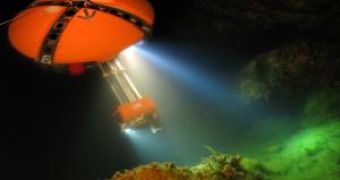NASA has funded an expedition to search for the submerged bottom of the deepest sinkhole on Earth, El Zacat?n, in Mexico. A robotic submarine will try to find out more about the geothermal sinkhole and what lives down there.
A sinkhole, also known as a cenote, is a natural depression or hole in the surface topography caused by the removal of soil or bedrock, often both, by water. Sinkholes may vary in size from less than a meter to several hundred meters in diameter and depth and vary in form from soil-lined bowls to bedrock-edged chasms. They may be formed gradually or suddenly and are found worldwide.
El Zacat?n is a geothermal sinkhole believed to have a depth of more than 282 meters (925 ft) whose bottom has not yet been reached, although at least one diver is known to have died while attempting to reach it.
The submarine is called DEPTHX, Deep Phreatic Thermal Explorer, is an unmanned probe designed to find out more about the dimension of the sinkhole, the geothermal vents that produced and fuel it and if there are any lifeforms down there.
It's a 2.5-meter-long (8.2 ft) unmanned probe that will collect water samples and rock samples from the walls, while testing new technologies and methods that might be useful in other underwater missions.
A team of researchers at Carnegie Mellon University's Robotics Institute will control and oversee the applications. It will be led by Bill Stone of Stone Aerospace in Austin, Texas and Associate Research Professor David Wettergreen form Carnegie.
"We'll spend the first two days checking out DEPTHX's sensors, updating its software and performing a test dive to 250 meters to check its pressure housings," Wettergreen said. "We'll then have six days to complete the science program. It's an ambitious program, but the vehicle performed well in two earlier field tests at the La Pilita cenote in Mexico."
This could be even considered a test for future submarine robots that would explore the oceans hidden under the icy crust of Europa, one of Jupiter's moons.

 14 DAY TRIAL //
14 DAY TRIAL //